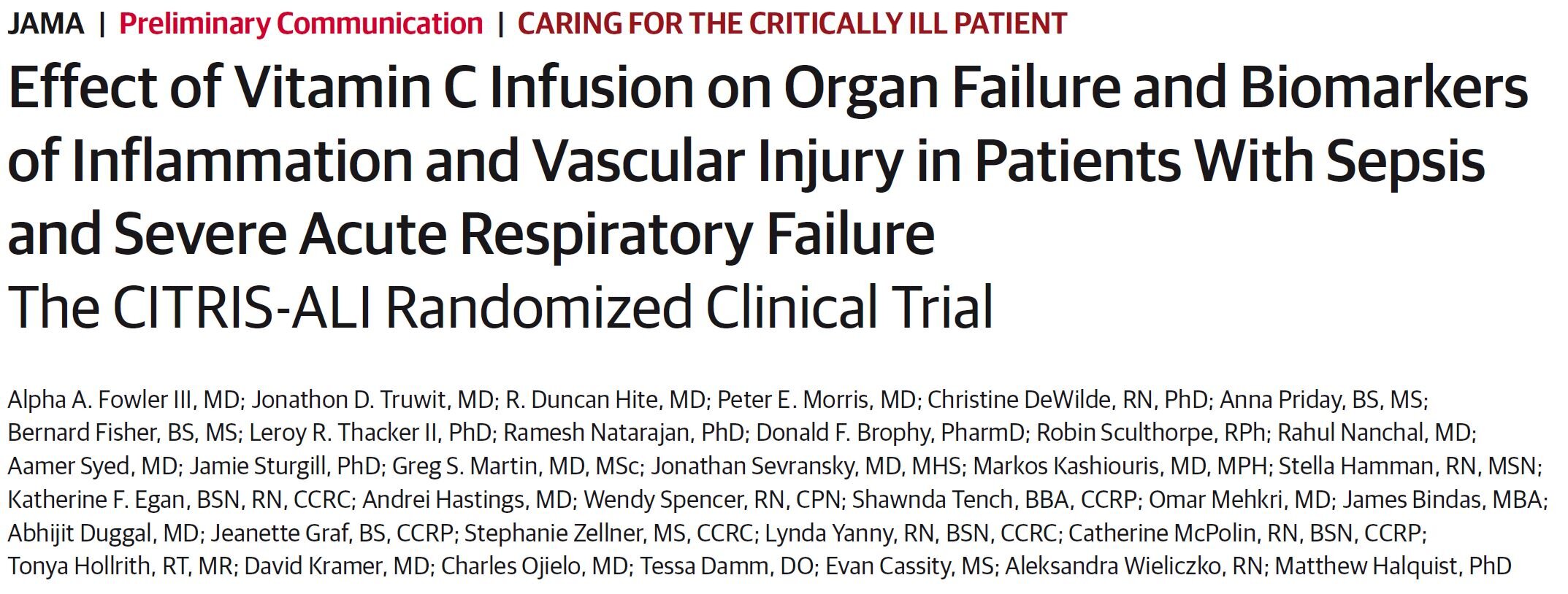Vitamin C for Sepsis Suffers a Setback. Or a Step-Forward. It's Complicated.
/The CITRIS-ALI study found no difference in primary outcomes among patients with sepsis treated with vitamin C versus placebo. But there was a difference in a secondary outcome - overall mortality.
When it comes to sepsis and septic shock, docs are used to disappointment. When I was training, the new hotness was stress-dose steroids and dual coverage for Gram negatives. Then Rivers’ early goal-directed therapy, then activated protein C.
Time and again, early dramatic successes gave way to less impressive or negative studies and the hope that there was a silver bullet for sepsis diminished.
Marik’s study in Chest was dramatic. But some argued it was too good to be true.
But one therapy has proven tantalizingly resilient, not only for reports of dramatic successes but also because of its low cost and virtual absence of side effects. That therapy? Vitamin C.
Dateline June, 2017. Dr. Paul Marik publishes an observational before / after study in Chest that many in the community called simply too good to be true.
47 patients with sepsis before institution of a vitamin C based protocol – mortality rate 40%.
47 patients after institution of a vitamin C protocol – mortality rate 8.5%. Not a randomized trial, but crazy good results.
I spoke with Dr. Marik – asking how things have gone since he published the Chest paper:
“Patients in our ICU do not die of sepsis. It just does not happen.”
-Paul Marik, MBBCh
Chief, Pulmonary and Critical Care Medicine
Eastern Virginia Medical School
But the lack of a randomized trial was a real blemish in this area research. Skeptics noted that before/after studies are uniquely susceptible to selection bias, even cherry picking. Show us the evidence.
Well, the evidence may be here. Though it’s not all we would have hoped for.
The CITRIS-ALI trial appears in JAMA this week. It enrolled 167 patients with sepsis and ARDS and randomized them to high dose IV vitamin C 50mg/kg every 6 hours for 96 hours - versus placebo in a double-blind fashion. The primary outcome was NOT mortality, but rather changes in inflammatory biomarkers and SOFA score. I asked lead author Dr. Berry Fowler why the surrogate outcomes:
“We were afraid to put mortality as a primary outcome, when we designed it. And we were thinking you know, holy cow, if we put this as a primary outcome, and it fails, you can kiss vitamin C goodbye.”
-Alpha (Berry) Fowler, MD
Chair, Pulmonary Disease and Critical Care Medicine
VCU School of Medicine
In other words, this was going to be a small study. You’d therefore need a big difference in a hard outcome like mortality to achieve statistical significance – they played it safe, and looked at changes in continuous metrics like SOFA score for their primary outcome.
No effects here, but note the patients were pretty sick when they got randomized.
The team may be regretting that decision. At 96 HOURS there was no difference in SOFA score, c-reactive protein, or thrombomodulin levels in the two groups.
Primary outcome – negative – no effect of vitamin C.
What do I do with that?!
-Dawn, Waitress.
Except that, oh yeah, there were fewer deaths in the Vitamin C arm: 30% mortality versus 46% in the placebo arm.
To quote Dawn from the hit Broadway musical “Waitress”, “What do I do with that?”.
I asked Dr. Fowler – did he consider this study a success?
“I’m pretty excited about it. It’s a small trial. I realize you can’t say much about 167 patients, but it’s at least a start.”
-Alpha (Berry) Fowler, MD
Chair, Pulmonary Disease and Critical Care Medicine
VCU School of Medicine
Why can’t we just say – “look, significantly lower mortality in the Vitamin C arm! Who cares about the semantics of primary and secondary outcomes”.
The reason this is an issue becomes clear if you imagine the opposite outcome occurred – no difference in mortality between Vitamin C and placebo. Since mortality was a secondary outcome, the authors could legitimately say “we didn’t power the study for mortality – this was a small study looking at intermediate outcomes” and we’d all be happy with that. In other words, if we embrace the mortality outcome here we’re basically saying there’s no way to lose with this study design. Significant difference in mortality? Sing it from the rooftops. No difference in mortality? Oh well, it was a secondary outcome anyway.
So… back to my question. What do we do?
The pat answer is call for more research. If nothing else, the Vitamin C researchers have earned themselves the right (and hopefully the funding) for a truly large scale study.
But what do we do in the meantime? If this were a drug with big risks, or if it were particularly expensive, I’d do the slow medicine thing – wait for more info.
But… it’s not expensive. And it’s not that risky. The nephrologist in me was worried about oxalate nephropathy, but apparently that hasn’t emerged. Dr. Fowler pointed out to me that IV vitamin C causes the point-of-care glucose checks to read too high – helpful FYI there.
But basically – this is a pretty low risk intervention. It’s easy for me to sit here and say “unless the patient has scurvy, wait for more data”. But if a loved one was in the ICU with sepsis, would you ask for Vitamin C? After reviewing the literature to prepare for this commentary, I’d be hard pressed to dismiss it out of hand.
This commentary first appeared on medscape.com.




